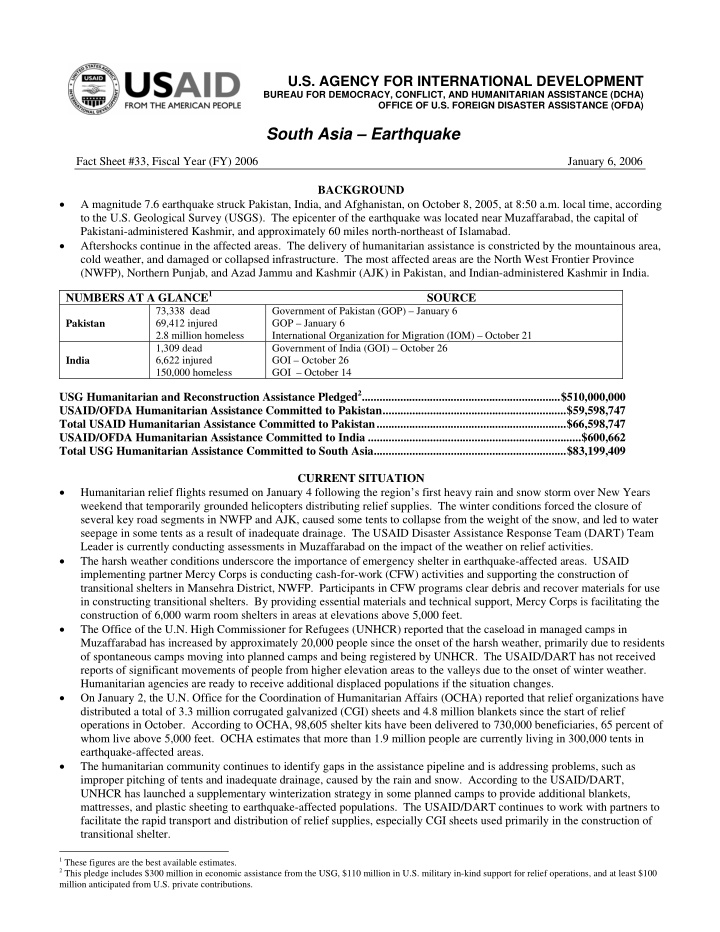



U.S. AGENCY FOR INTERNATIONAL DEVELOPMENT BUREAU FOR DEMOCRACY, CONFLICT, AND HUMANITARIAN ASSISTANCE (DCHA) OFFICE OF U.S. FOREIGN DISASTER ASSISTANCE (OFDA) South Asia – Earthquake Fact Sheet #33, Fiscal Year (FY) 2006 January 6, 2006 BACKGROUND • A magnitude 7.6 earthquake struck Pakistan, India, and Afghanistan, on October 8, 2005, at 8:50 a.m. local time, according to the U.S. Geological Survey (USGS). The epicenter of the earthquake was located near Muzaffarabad, the capital of Pakistani-administered Kashmir, and approximately 60 miles north-northeast of Islamabad. • Aftershocks continue in the affected areas. The delivery of humanitarian assistance is constricted by the mountainous area, cold weather, and damaged or collapsed infrastructure. The most affected areas are the North West Frontier Province (NWFP), Northern Punjab, and Azad Jammu and Kashmir (AJK) in Pakistan, and Indian-administered Kashmir in India. NUMBERS AT A GLANCE 1 SOURCE 73,338 dead Government of Pakistan (GOP) – January 6 Pakistan 69,412 injured GOP – January 6 2.8 million homeless International Organization for Migration (IOM) – October 21 1,309 dead Government of India (GOI) – October 26 India 6,622 injured GOI – October 26 150,000 homeless GOI – October 14 USG Humanitarian and Reconstruction Assistance Pledged 2 ...................................................................$510,000,000 USAID/OFDA Humanitarian Assistance Committed to Pakistan..............................................................$59,598,747 Total USAID Humanitarian Assistance Committed to Pakistan................................................................$66,598,747 USAID/OFDA Humanitarian Assistance Committed to India ........................................................................$600,662 Total USG Humanitarian Assistance Committed to South Asia.................................................................$83,199,409 CURRENT SITUATION • Humanitarian relief flights resumed on January 4 following the region’s first heavy rain and snow storm over New Years weekend that temporarily grounded helicopters distributing relief supplies. The winter conditions forced the closure of several key road segments in NWFP and AJK, caused some tents to collapse from the weight of the snow, and led to water seepage in some tents as a result of inadequate drainage. The USAID Disaster Assistance Response Team (DART) Team Leader is currently conducting assessments in Muzaffarabad on the impact of the weather on relief activities. • The harsh weather conditions underscore the importance of emergency shelter in earthquake-affected areas. USAID implementing partner Mercy Corps is conducting cash-for-work (CFW) activities and supporting the construction of transitional shelters in Mansehra District, NWFP. Participants in CFW programs clear debris and recover materials for use in constructing transitional shelters. By providing essential materials and technical support, Mercy Corps is facilitating the construction of 6,000 warm room shelters in areas at elevations above 5,000 feet. • The Office of the U.N. High Commissioner for Refugees (UNHCR) reported that the caseload in managed camps in Muzaffarabad has increased by approximately 20,000 people since the onset of the harsh weather, primarily due to residents of spontaneous camps moving into planned camps and being registered by UNHCR. The USAID/DART has not received reports of significant movements of people from higher elevation areas to the valleys due to the onset of winter weather. Humanitarian agencies are ready to receive additional displaced populations if the situation changes. • On January 2, the U.N. Office for the Coordination of Humanitarian Affairs (OCHA) reported that relief organizations have distributed a total of 3.3 million corrugated galvanized (CGI) sheets and 4.8 million blankets since the start of relief operations in October. According to OCHA, 98,605 shelter kits have been delivered to 730,000 beneficiaries, 65 percent of whom live above 5,000 feet. OCHA estimates that more than 1.9 million people are currently living in 300,000 tents in earthquake-affected areas. • The humanitarian community continues to identify gaps in the assistance pipeline and is addressing problems, such as improper pitching of tents and inadequate drainage, caused by the rain and snow. According to the USAID/DART, UNHCR has launched a supplementary winterization strategy in some planned camps to provide additional blankets, mattresses, and plastic sheeting to earthquake-affected populations. The USAID/DART continues to work with partners to facilitate the rapid transport and distribution of relief supplies, especially CGI sheets used primarily in the construction of transitional shelter. 1 These figures are the best available estimates. 2 This pledge includes $300 million in economic assistance from the USG, $110 million in U.S. military in-kind support for relief operations, and at least $100 million anticipated from U.S. private contributions.
Recommend
More recommend